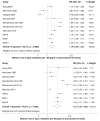Unprocessed red and processed meats and risk of coronary artery disease and type 2 diabetes--an updated review of the evidence
- PMID: 23001745
- PMCID: PMC3483430
- DOI: 10.1007/s11883-012-0282-8
Unprocessed red and processed meats and risk of coronary artery disease and type 2 diabetes--an updated review of the evidence
Abstract
Growing evidence suggests that effects of red meat consumption on coronary heart disease (CHD) and type 2 diabetes could vary depending on processing. We reviewed the evidence for effects of unprocessed (fresh/frozen) red and processed (using sodium/other preservatives) meat consumption on CHD and diabetes. In meta-analyses of prospective cohorts, higher risk of CHD is seen with processed meat consumption (RR per 50 g: 1.42, 95 %CI = 1.07-1.89), but a smaller increase or no risk is seen with unprocessed meat consumption. Differences in sodium content (~400 % higher in processed meat) appear to account for about two-thirds of this risk difference. In similar analyses, both unprocessed red and processed meat consumption are associated with incident diabetes, with higher risk per g of processed (RR per 50 g: 1.51, 95 %CI = 1.25-1.83) versus unprocessed (RR per 100 g: 1.19, 95 % CI = 1.04-1.37) meats. Contents of heme iron and dietary cholesterol may partly account for these associations. The overall findings suggest that neither unprocessed red nor processed meat consumption is beneficial for cardiometabolic health, and that clinical and public health guidance should especially prioritize reducing processed meat consumption.
Figures


References
-
- Micha R, Wallace SK, Mozaffarian D. Red and processed meat consumption and risk of incident coronary heart disease, stroke, and diabetes mellitus: a systematic review and meta-analysis. Circulation. 2010;121(21):2271–83. The first systematic review and meta-analysis that assessed relationships between unprocessed red and processed meat consumption and risk of incident coronary heart disease, stroke, and type 2 diabetes. This meta-analysis provided evidence that the effects of meat consumption on cardiometabolic outcomes might vary depending on the extent of processing i.e., whether or not the meat is fresh (unprocessed) or has been processed and preserved for long-term storage, typically by adding high amounts of salt, as well as other preservatives such as nitrates. - PMC - PubMed
-
- Mozaffarian D, Wu JH. Omega-3 fatty acids and cardiovascular disease: effects on risk factors, molecular pathways, and clinical events. J Am Coll Cardiol. 2011;58(20):2047–67. - PubMed
-
- Mozaffarian D. Braunwald’s Heart Disease: a Textbook of Cardiovascular Medicine. Philadelphia: 2012. Chapter 48: Nutrition and Cardiovascular Diseases.
-
- Institute of Medicine of the National Academies. Evaluation of Biomarkers and Surrogate Endpoints in Chronic Disease. 2010. - PubMed
Publication types
MeSH terms
Grants and funding
LinkOut - more resources
Full Text Sources
Other Literature Sources
Medical

